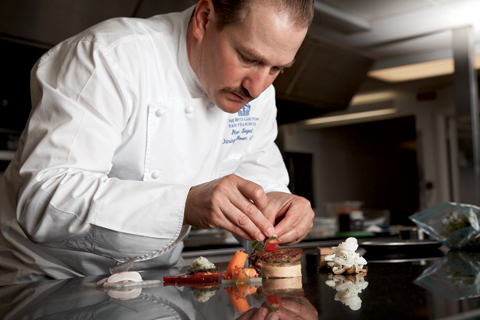By Chef Ron Siegel
As we enter into the late summer months, tomatoes are such an obvious ingredient on which to focus, but they are impossible to avoid because they are a true representation of summer and the culinary delights that the season brings. When I am choosing tomatoes for a particular dish, one of the things that I test out is their aroma. For me, they should smell like the vine with a strong scent of being freshly picked.
he 10-year mean levels of kaempferol were 97 percent higher in organic tomatoes and the quercetin levels were 79 percent higher than in conventional tomatoes.
I have spoken here many times about how important I find fresh, natural ingredients to be while preparing my menus, leading me to make many trips to our local farmers’ markets and develop relationships with various organic farmers in the region. Just to the northwest of us, at the University of California, Davis is the Tomato Genetics Stock Center with more than 2,750 genetic varieties of the fruit (which the U.S. Supreme Court officially declared as a vegetable in 1893). Backing up my devotion to organic products, the university is in the midst of a 100-year-long experiment that began in 1991, which, so far, has found that organically grown tomatoes contain nearly double the concentration of the antioxidant flavonoids, quercetin and kaempferol, than conventionally grown tomatoes. The 10-year mean levels of kaempferol were 97 percent higher in organic tomatoes and the quercetin levels were 79 percent higher than in conventional tomatoes.
With statistics like those, I insist that you try this delicious recipe that incorporates a tomato gelée. And just for fun, I have also included two other favorite summertime recipes that are often requested by our regular patrons.
Cheers,
The Dining Room at The Ritz-Carlton, San Francisco
600 Stockton Street
San Francisco, CA 94108
415.296.7465
Aiu with Tomato Gelée, Basil Seeds and Basil Oil
- 2 ounces Aiu fillet
- 3 pounds ripe heirloom tomatoes
- 6 grams (approximately 2 sheets) of sheet gelatin
- 1/2 tablespoon basil seeds
- 2 bunches of basil
- Olive oil
- Cheesecloth
Wash and core the tomatoes. Puree them in a blender or food processor. Take the puree liquid blend and strain it through a cloth napkin into a bowl. The remaining liquid in the bowl will look clear like water, with a slight reddish tint to it.
Take 6 grams of sheet gelatin, soak it in cold water, and let it soften. Bring the tomato consommé to a very low simmer. Once the gelatin sheets are soft, slowly add them in, diluting them in the tomato consommé. Next, pour the mixture onto the flat surface of a dish and refrigerate.
Put the basil seeds in a small bowl and cover them in water until all of the water is absorbed. The consistency will become similar to tapioca, where it is transparent on the outside with a “black eye” in the center where the seeds have formed together.
Next, pick the leaves off of the basil. Blanch in boiling water for one minute and then place in an ice bath. Let it cool, and then wring out any excess water. Place basil leaves into a blender and then drizzle just enough olive oil to cover the top portion of the basil. Puree until it is a smooth paste. Then strain the basil puree through cheesecloth until you are left with green basil oil.
Sauté the Aiu filet for 10 to 20 seconds on one side, flip it over and sauté it for just one second on the other.
Drizzle the basil oil on a plate. Place the basil seed around the plate. Put the tomato gelée in the center and the sautéed Aiu on top.
Seared Toro with Matsutake Mushrooms, Edamame, and Mirin Reduction
- 4 two-ounce packs Toro
- 1 tablespoon cracked Muntock white pepper
- 1 tablespoon vanilla sea salt
- 2 shallots
- ¼ cup mirin
- ½ cup brown chicken stock
- 1 tablespoon butter
- 1 matsutake mushroom
- 2 to 3 tablespoons edamame beans
Blanch the edamame beans and set aside. Slice the shallots paper-thin and put them in a stainless or non-reactive pot. Add the mirin and reduce down until it becomes a syrupy consistency. Add brown chicken stock, let simmer 5 to 10 minutes, strain and set aside.
Season the toro lightly with salt. Sear lightly in a pan.
Using a mandoline or a very sharp knife, shave the matsutake very thinly and place on a flat layer on a plate. Warm the edamame beans, place on top of the mushrooms. Slice toro and fan out on the plate.
Reheat the mirin reduction and mount with butter; drizzle on plate. Sprinkle with vanilla sea salt and Muntock white pepper. Serve.
Quail Egg 64°
- 1 quail egg
- Brioche bread
- 1 teaspoon golden osetra caviar
- Pinch of finely ground cedar chips
- Chopped chives
Set up an immersion circulator at 64 degrees Celsius. Cook the quail egg for at least 13 minutes in the immersion circulator.
Make brioche croutons by finely dicing some brioche bread. Sauté in clarified butter until lightly browned. Chop a small amount of fresh chives. Grate the cedar chips so that they are small enough to fit in a small, portable smoker.
Cover the glass container with plastic wrap very tightly. Heat the tip of a pastry tip and poke a small hole through the plastic on one side. On the opposite side of the plastic-wrapped surface, make a quenelle of caviar and place the croutons next to the quenelle. Carefully crack the egg open, starting from the larger side of the egg. Place the egg on the croutons between the quenelle and croutons so it does not run down the side of the surface. Put cedar chips in bowl of the smoker; aim the output into the hole you created with the pastry tip. Cover the hole with a teaspoon. Serve immediately. When the spoon is used to eat the egg, the smoke will escape and the diner will enjoy the smell of the cedar smoke.





















